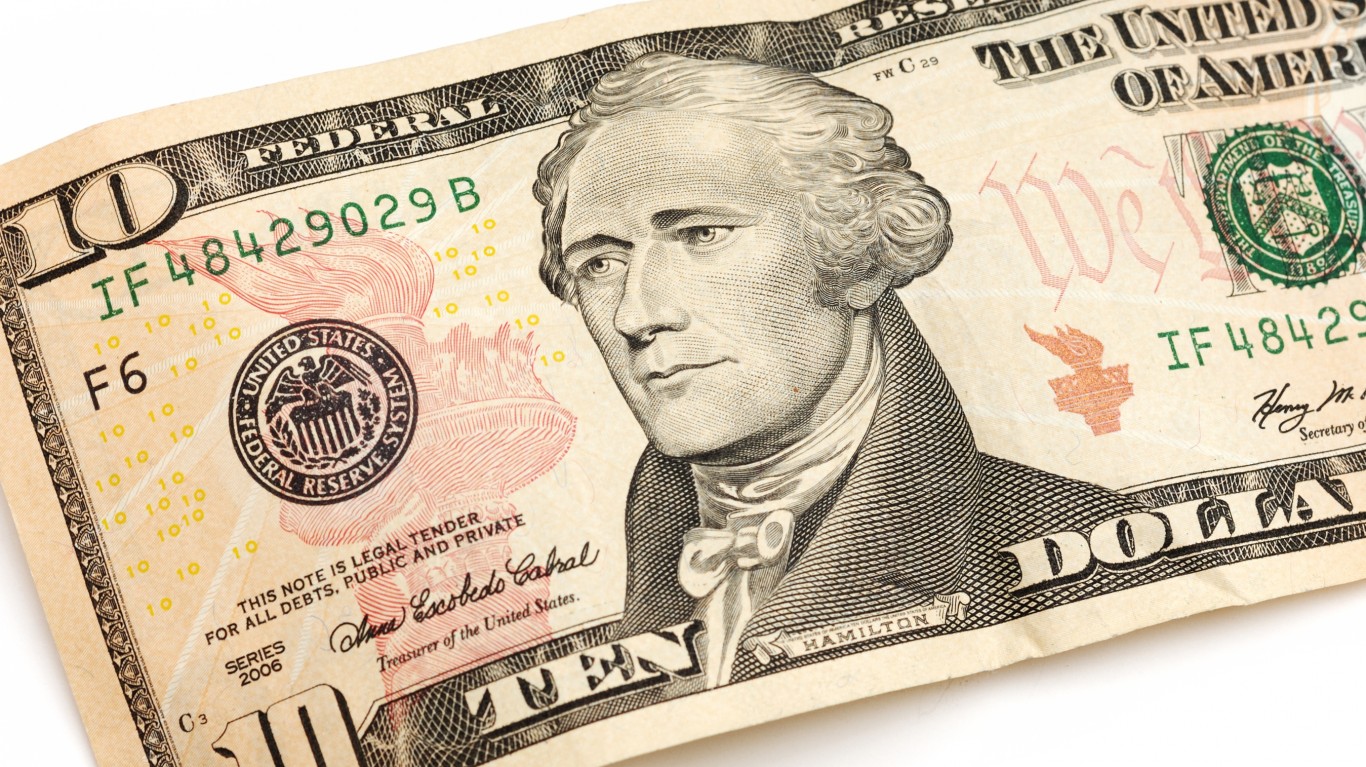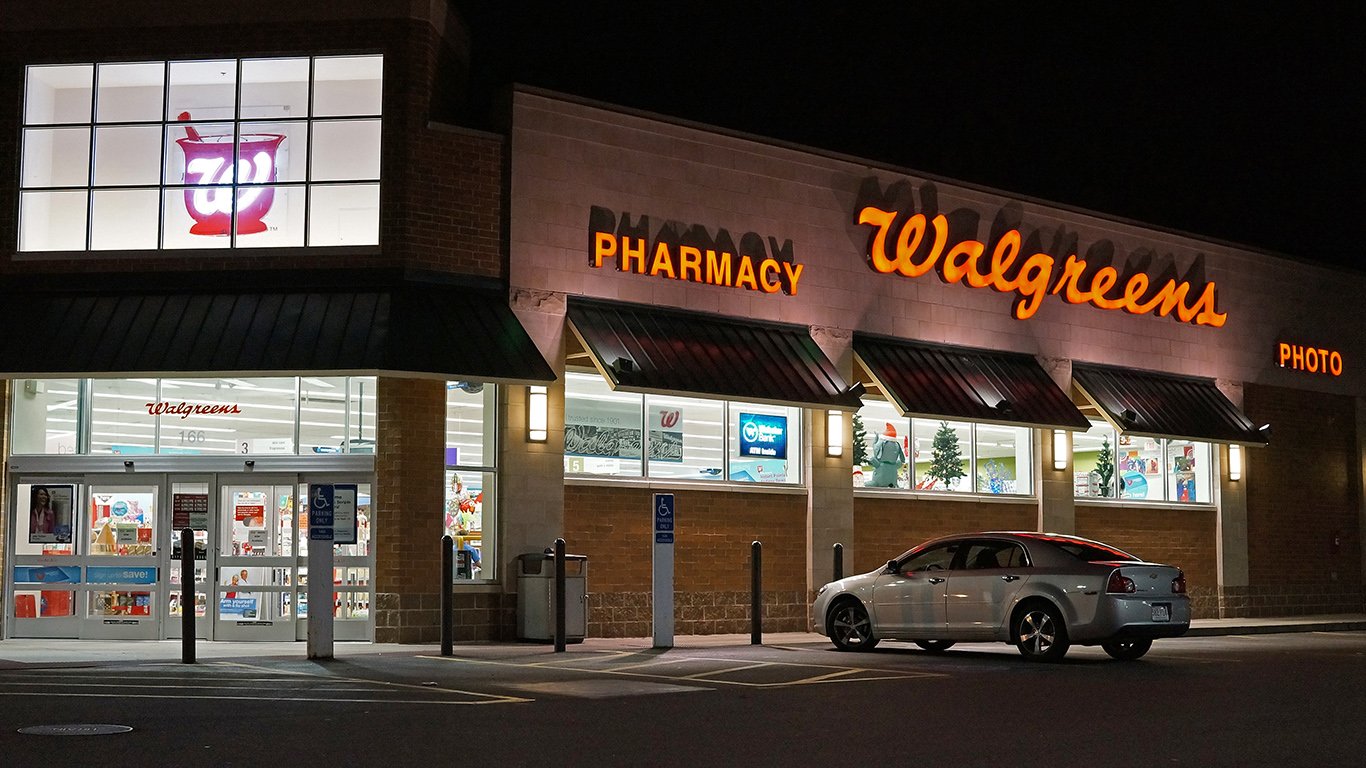
Source: gemphotography/ThinkStock
Read: America’s Richest Cities
Read: America’s Poorest Cities
What has not changed much is the gulf that separates how much people make, depending on where they live. In McAllen, Tex., the median household earned just $31,077 in 2011. In the Washington D.C. metropolitan area, the median household earned close to three times as much. These differences reflect vastly different economies and demographic makeups. Based on the 2011 Census Bureau American Community Survey, 24/7 Wall St. identified the cities with the highest and lowest incomes.
The biggest factor in determining a city’s income, according to Alex Friedhoff, a Research Analyst at Brookings Institute’s Metropolitan Policy Program, is the underlying industries that employ the most residents, as well as the type of jobs. High-tech jobs, particularly those related to computers and information technology, tend to pay higher salaries and are more likely to be located in areas with affluent residents. On the other hand, most of the jobs in the lower-income metro areas tend to be in retail, service, agriculture and low-tech manufacturing.
A review of the employment characteristics of the different cities confirms this. Included among the richest cities are the information technology centers of Boston and Boulder, the finance hub of Bridgeport-Stamford, and the San Jose region, better known as Silicon Valley, home to some of the largest chipmakers and computer parts manufacturers in the world. Nationwide, 10.7% of workers are employed in professional, scientific, and management positions. Of the 10 wealthy metro regions, nine have a larger proportion of workers in that sector. In Boulder, 21.9% fall into that category.
In the poorest economies, there is a much higher proportion of low-end manufacturing and retail jobs. In the U.S. as a whole, 11.6% of workers are employed in retail. In the 10 poorest metro areas, eight exceed that number by a wide margin, including Hot Springs, Arkansas, where 17.3% of its workforce is employed in retail.
Elizabeth Kneebone, a fellow at the Brookings Institute, explained that these poor areas are seeing an increase in low-wage jobs. “That is something we’ve seen in this recovery. Over the decade, the kinds of jobs we are growing are in lower-skill, low-wage industries like hospitality, food service, and retail. Those are jobs that don’t tend to pay the kinds of wages that the jobs we lost did.”
Other key indicators released for 2011 show the disparity between these rich and poor cities. Poverty rates in some of the poor cities are well above the national rate of 15.3%. In McAllen, Tex., more than 35% of residents lived below the poverty level in 2011. In Washington, D.C., one of the wealthiest cities, just 8.3% of residents lived in poverty.
To identify the U.S. metropolitan statistical areas, or MSAs, with the highest and lowest median household income, 24/7 Wall St. reviewed city data on income, poverty rate, median home price and health insurance from the U.S. Census Bureau’s 2011 American Community Survey (ACS). Based on Census treatment, median household income for all years is adjusted for inflation. We also reviewed unemployment data provided by the Bureau of Labor Statistics. The Census Bureau breaks out the data only for the 366 MSAs with 50,000 people or more. All ranks are out of those 366 metropolitan areas, except for unemployment, which is out of 372 areas.
These are America’s richest cities.
10. Poughkeepsie-Newburgh-Middletown N.Y.
>Median household income: $66,734
>Population: 672,871 (79th highest)
>Unemployment rate: 7.6% (116th lowest)
>Pct. households below poverty line: 12.2% (49th lowest)
The last few years have proven difficult for Poughkeepsie area residents. Median income fell from $71,473 in 2007 to $66,734 in 2011, while the percentage of the population living below the poverty level has risen from 9.8% to 12.2% in that time. Additionally, just 7.1% of households earned in excess of $200,000 last year, above the national proportion of 5.6%. Although home prices fell by nearly 16% during that time, the area’s median home price of $279,400 in 2011 was more than $100,000 above the national median. The 2011 unemployment rate for the Poughkeepsie area was just 7.6%, significantly less than the national rate of 8.9% for the year.
9. Boulder, Colo.
>Median household income: $68,637
>Population: 299,378 (158th highest)
>Unemployment rate: 6.2% (45th lowest)
>Pct. households below poverty line: 14.1% (100th lowest)
Nearly 22% of Boulder’s working population was employed in professional, scientific and management services, the highest rate in the U.S. The largest employer in the area as of 2011 was the University of Colorado, with 6,800 jobs. Several technology giants also have a sizable presence in the area. IBM was the largest private-employer in the Boulder region, employing approximately 2,800 people. Oracle employed 1,900 people in the region, while Seagate Technology employed 1,104. This large flock of highly-skilled professionals led to 12.5% of households making more than $200,000 in 2011, the sixth highest proportion in the country. The median home value was $344,600, nearly twice the national figure.
8. Boston-Cambridge-Quincy, Mass.-N.H.
>Median household income: $69,455
>Population: 4,591,112 (10th highest)
>Unemployment rate: 6.6% (55th lowest)
>Pct. households below poverty line: 10.7% (22nd lowest)
Just 4.7% of Boston area residents did not have health insurance coverage in 2011, which is less than all but three metro areas — all of which are in Massachusetts. Over 27% of residents worked in either education or health care, while more than 14% worked in scientific or management positions. This isn’t surprising given Boston’s numerous top hospitals, universities and research institutions. The area also had some of the nation’s most expensive houses, with a 2011 median home value of $356,100 and 4.1% of homes worth over $1 million.
Also Read: America’s Richest States
7. Anchorage, Alaska
>Median household income: $71,700
>Population: 387,516 (133rd highest)
>Unemployment rate: 6.7% (63rd lowest)
>Pct. households below poverty line: 8.7% (6th lowest)
Anchorage has a thriving petroleum industry, with companies such as BP employing thousands of people in the oil fields in generally middle-income positions. While home values fell in the vast majority of metropolitan areas between 2010 and 2011, in Anchorage they actually rose by almost 1%. The percentage of people on the opposite ends of the wealth spectrum was relatively small. Only 8.7% of households lived below the poverty line in 2011, well below the national rate of 15.9%. Meanwhile, just 6.8% of households earned $200,000 or more in 2011. While this was higher than the national rate of 5.6%, it is the only metro among the 10 richest where fewer than 10% earned more than $200,000 or more.
6. San Francisco-Oakland-Fremont, Calif.
>Median household income: $71,975
>Population: 4,391,037 (11th highest)
>Unemployment rate: 9.4% (127th highest)
>Pct. households below poverty line: 11.9% (45th lowest)
The median home value in the San Francisco area of $561,200 was the second highest, right behind the nearby San Jose metropolitan area. Meanwhile, more than 14% of homes were worth at least $1 million in 2011, the third-highest percentage of all metropolitan areas. More than one in six professionals in the area worked in professional, scientific and management services, the fourth-highest rate of all metro areas. High-skilled labor opportunities allowed 14.6% of households to earn more than $200,000 a year. Despite the success of some, the unemployment rate was more than half a percentage point above the national rate.
5. Trenton-Ewing, N.J.
>Median household income: $73,890
>Population: 367,063(140th highest)
>Unemployment rate: 7.7% (123rd lowest)
>Pct. households below poverty line: 11.4% (34th lowest)
The median home value in the Trenton metro area was $282,700. While this is more than $100,000 above the U.S. value, it is significantly less than many other rich metros such as San Jose, Washington D.C. and Boston. Yet some of the nine townships in Mercer County, which comprises most of the metro area, are very affluent. For instance, the median household income in the West Windsor township was $137,625 a year in 2010, while the median income in the Princeton township, as of 2010, was $107,071. The most notable employers in the region are Princeton University and NRG Energy, a utility company with over $8 billion in revenue.
4. Oxnard-Thousand Oaks-Ventura, Calif.
>Median household income: $74,623
>Population: 831,771 (63rd highest)
>Unemployment rate: 10.1% (93rd highest)
>Pct. households below poverty line: 11.3% (32nd lowest)
Home prices in the Oxnard area, part of the Greater Los Angeles region, declined by more than 32% between 2007 and 2011, including a 5.5% dip between 2010 and 2011. Despite that, the median home value in the Oxnard area was $433,100, the eighth-highest among all metro areas. Furthermore, 6% of homes were worth at least $1 million, triple the U.S. rate. Renting is not particularly cheap either. The median monthly rent of $1,382 was the fourth-highest rent in the country and higher than the national median by more than $500.
Also Read: The Most Dangerous Cities in America
3. Bridgeport-Stamford-Norwalk, Conn.
>Median household income: $77,289
>Population: 925,899 (56th highest)
>Unemployment rate: 8.2% (163rd lowest)
>Pct. households below poverty line: 9.4% (13th lowest)
In Bridgeport, 12% of the residents work in the finance and insurance industry, the third-highest percentage of all metro areas. The metropolitan area is home to numerous hedge funds, where executives can earn millions of dollars annually. Furthermore, many people who work on Wall Street also settle in western Connecticut. More than one in five households earned at least $200,000 in the area, the highest percentage of all metro areas in the country. Almost 14% of homes were worth at least $1 million as of 2011, the fourth highest percentage in the country.
2. San Jose-Sunnyvale-Santa Clara, Calif.
>Median household income: $84,012
>Population: 1,865,450 (31st highest)
>Unemployment rate: 9.9% (105th highest)
>Pct. households below poverty line: 10.6% (21st lowest)
The San Jose area is home to some of America’s top technology companies, which employ highly-compensated engineers and other technology professionals. More than 45% of adult residents had at least a college degree as of 2010, according to a recent study by the Brookings Institute, making San Jose the second-most educated metropolitan region in the country. The median home value as of 2011 was $618,000 and 18.7% of homes were worth at least $1 million, both the highest in the country. Despite having the second-largest median household income in 2011, the area’s unemployment rate of 9.9% was significantly higher than the national rate of 8.9% as California has suffered especially hard from the housing bust.
1. Washington-Arlington-Alexandria, D.C.-Va.-Md.-W.Va.
>Median household income: $86,680
>Population: 5,703,948 (7th highest)
>Unemployment rate: 5.8% (29th lowest)
>Pct. households below poverty line: 8.3% (5th lowest)
The Washington area is filled with tens of thousands of highly-skilled professionals in a host of different industries, from consulting to law to defense contracting. In fact, the Brookings Institute dubbed the area the most educated in the country because 46.8% of adult residents in 2010 had at least a college degree. The median home value in the area was more than double the national figure of $173,600, while 4.5% of homes were worth over $1 million, compared to 2% nationally. The median rent of $1,391 in Washington D.C. was higher than all but the San Jose and Honolulu metropolitan areas.
-Michael B. Sauter, Alexander E.M. Hess, Sam Weigley
Also Read: America’s Poorest Cities
Sponsored: Attention Savvy Investors: Speak to 3 Financial Experts – FREE
Ever wanted an extra set of eyes on an investment you’re considering? Now you can speak with up to 3 financial experts in your area for FREE. By simply
clicking here you can begin to match with financial professionals who can help guide you through the financial decisions you’re making. And the best part? The first conversation with them is free.
Click here to match with up to 3 financial pros who would be excited to help you make financial decisions.
Thank you for reading! Have some feedback for us?
Contact the 24/7 Wall St. editorial team.



